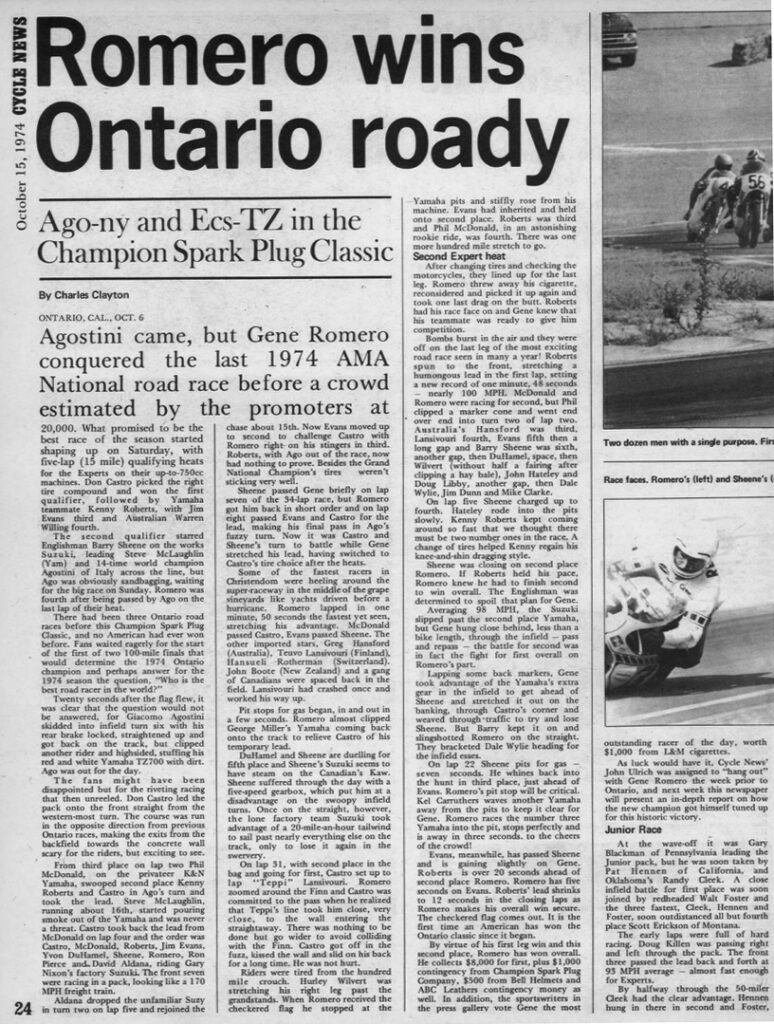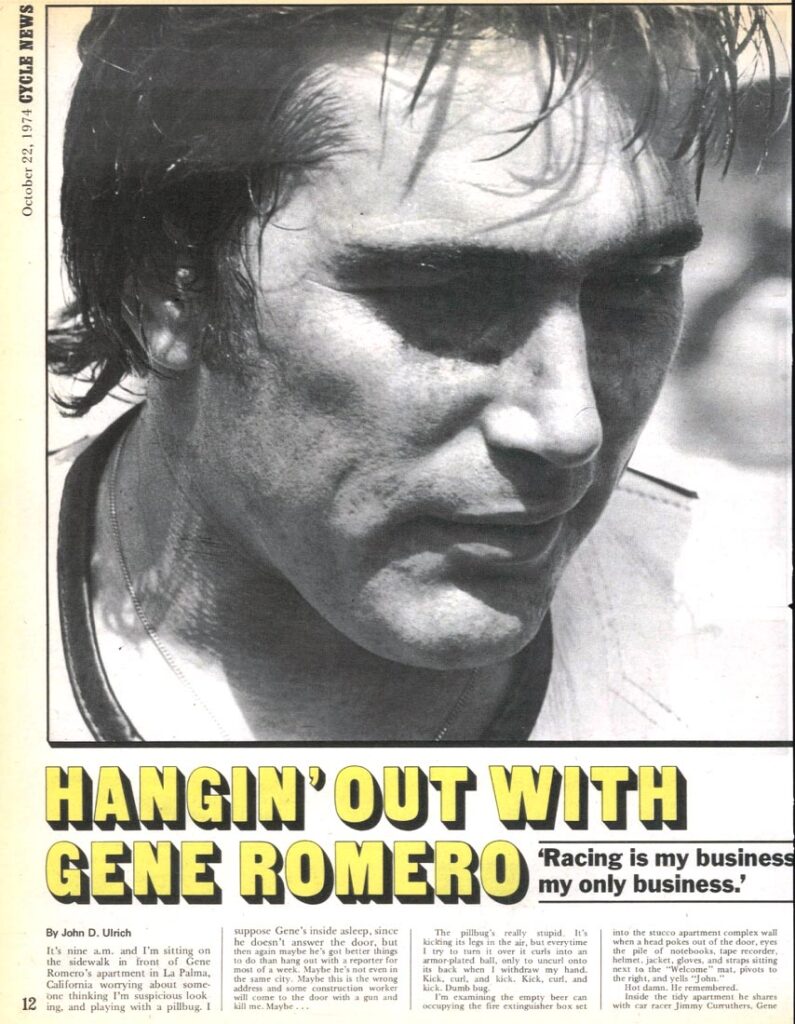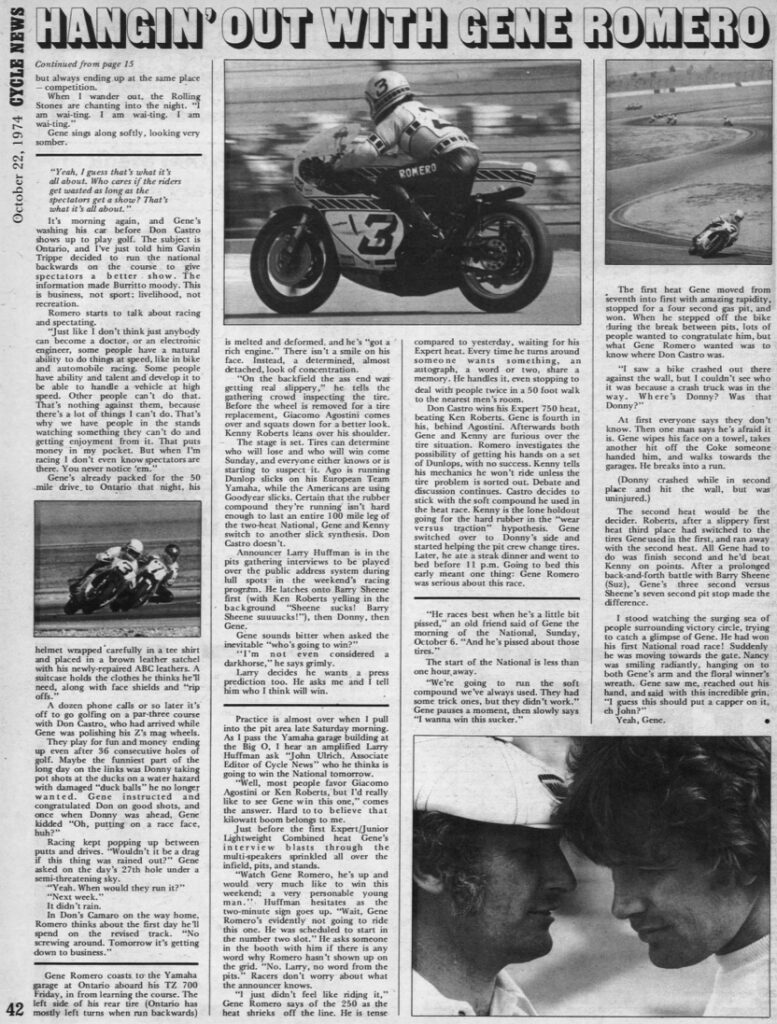| April 28, 2024
Cycle News Archives
COLUMN
Burritto Makes His Own Luck
By Kent Taylor
It has been said that it is better to be lucky than good. But it is better still to be lucky and good, especially if you are a motorcycle racer and in 1974, at the final AMA National of the season, Team Yamaha’s Gene Romero was both.
The Grand National Championship season had featured a fairly tight battle between Harley-Davidson’s Gary Scott and Yamaha’s Kenny Roberts. Roberts won (for the second year in a row) and Scott had finished second (for the second year in a row). But even though the championship had been decided, there was still another race to be run. It was dubbed “The Champion Spark Plug Classic,” and it was unique among the other road races on the AMA schedule. While all other road races were one and done, this race, held at the Ontario Motor Speedway, would be run in two legs. One hundred miles, take a break, and then race another 100-mile leg. Just like motocross, it used the old Olympic scoring system to determine the overall winner.
 Gene Romero won the 200-mile Champion Spark Plug Classic in 1974 against a stacked field.
Gene Romero won the 200-mile Champion Spark Plug Classic in 1974 against a stacked field.
The grid would feature many of the top riders in the world. Besides the Yamaha trio of Roberts, Romero and Don Castro, world champions like Giacomo Agostini and Barry Sheene made the trip to Ontario. Teuvo Laernsivuori, Warren Willing, Gregg Hansford also made the voyage over different oceans to race that day. Yamaha, Suzuki, Kawasaki and even Harley-Davidson (its pushrod four-stroke V-twin, sucking up the undigested, but powerful two-stroke mist from the faster machines) were brands that would be scored in the top 10 results that day.
Of all the names on the line, most race fans would have likely made Romero their third, fourth or perhaps even fifth choice to come away with the win. Agostini had already won Daytona that season and Kenny Roberts had won nearly every other road race (Gary Nixon, as he was prone to do, had captured another victory at Loudon). The top non-American riders were all road-race specialists and even though Gene Romero was a former Grand National champion, he had yet to win an AMA race on anything other than dirt.
Another individual who would experience a double blessing of luck and goodness was Cycle News’ editor John Ulrich. Ulrich had just spent several days with Romero and his friends and had written up a fun feature for CN. Hanging with Romero at the grocery store, golf course and at his apartment—while his race buddies Dave Aldana and Don Castro stop by for sizzling steaks and raucous race chatter—gave Ulrich a little insight into the man that was beloved by everyone on the AMA circuit. But even though he was known as a prankster and as a guy who would give a journalist a biting (though tongue-in-cheek) quote, Romero made one thing very clear to Ulrich: “Racing is my business,” he said. “My only business.”
 A week prior to Gene Romero’s first-ever AMA road race win at the Ontario Motor Speedway, John Ulrich had spent several days with him for a feature in CN.
A week prior to Gene Romero’s first-ever AMA road race win at the Ontario Motor Speedway, John Ulrich had spent several days with him for a feature in CN.

The 1974 Champion Spark Plug Classic would be a harbinger for the sport of motorcycle road racing. But it would have nothing to do with spark plugs. Tire technology was becoming the focus for riders and mechanics, and it was Romero’s own Yamaha TZ700 that would be forcing the issue. The powerful four-cylinder two-stroke machine had been eviscerating track records around the world that year and suddenly, rubber that had been good enough for years was no longer ready for prime time.
Mechanics and riders struggled that day at Ontario with tire choices. “The ass end” says Romero, “was getting too slippery.” Roberts, whose skills were such that he could race anywhere on anything, is even threatening to not ride at all. Agostini is on Dunlops, but the American team riders’ bikes are Goodyear-shod. Different brands, different compounds, different men with their own experiences about what it feels like to have a tire break loose at speeds over 100 mph. Livelihoods and even lives are at stake, but, alas, a race is to be run and a choice must be made.
In what Ulrich refers to as “the wear versus traction” dilemma, Roberts makes his choice and Romero makes a different one. Roberts picks a harder compound, likely reasoning that it will last 100 miles. Gene Romero is opting for the softer, stickier tire, the one he says “we’ve always used.
“I want to win this sucker” he says.
When the flag fell for the first of the two 100-mile heats, it was Don Castro in front of the pack, which suddenly was shy one world champion: Agostini had a dustup with another rider and wound up on the ground and out for the day. Roberts and others followed Castro, with Romero around eighth, but moving up quickly. Castro would also crash out of the event. Romero passed everyone, including Roberts on his way into the lead. Sheene would pass him once, but Romero retook the lead. An almost disastrous collision with another rider while pitting for fuel nearly put him on his own ass end, but he would save it and cruise to a victory. Behind him, privateer Jim Evans had put in an outstanding ride to second, with Roberts third.
One down, one to go. When the second leg left the starting line, it would be Kenny Roberts out in front. Furious at his tire miscalculation in race one, the champ was now sporting the same shoes that his teammate had selected. With the softer compound, Roberts was in his good place, setting a new track record on lap one!
But this leg was only one battle. The war was still to be won and Romero didn’t need to beat Roberts; he just needed to beat everybody else, which is exactly what he did. When the results were tallied, his 1-2 topped Roberts’ 3-1. Gene Romero, who had muttered pre-race “I’m not even considered a dark horse,” had won his first-ever AMA road race, taking home a little more than $10,000 in prize money and contingencies (including $1000 from L&M cigarettes for the “The Most Outstanding Racer of the Day Award” voted on by the motorsports media).
Puzzlingly, many of those same writers used most of their ink to explain not how Gene Romero won, but rather, why Kenny Roberts didn’t. Champions are supposed to be victorious, so when Roger DeCoster, Bob Hannah and Jeremy McGrath came up short, there was always an explanation. Something went wrong, right?
A few months after winning the last road race national of 1974, Romero won the first road race of the 1975 season, which just happened to be the Daytona 200. It was a popular victory for the man known as “Burritto” (“two t’s” he quipped to Ulrich), but it happened after Kenny Roberts broke down, Teuvo Laernsivuori crashed, Johnny Cecotto got bumped to the back of the grid and the coffee machine at the infield cafe broke down.
The day after winning the 200, Romero visited his friend Barry Sheene, who was in the hospital. Sheene had been injured shortly before the big race, a victim of (cue dramatic minor key on pipe organ) a tire failure! Lighting up a couple of smokes, Romero accepted his buddy’s congratulations and then mused, “I wonder what kind of excuse they’re going to give me for winning this one?”
Lucky? Good? There’s yet another axiom in play here: you make your own luck. Congratulations, Burritto!CN